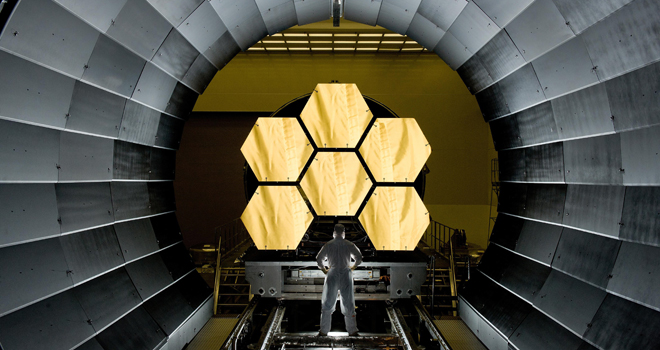Buoyed by the Senate’s recent promise of continued federal funding, NASA announced Monday that it was conducting tests on a critical component of the James Webb Space Telescope, the $8.7 billion replacement for the Hubble Space Telescope, due to be launched in 2018.
But professional astronomers remain concerned that the estimated cost of the telescope, which has ballooned from an original $5 billion, could sabotage its overall chances for success. After all, the House Appropriations Committee introduced legislation that would defund the project in July.
“Now is not the time to cut scientific research, which remains a vital driver for the long term economic success of our nation, especially in the high-tech fields supported by NASA,” said Kevin Marvel, executive officer of the American Astronomical Society, a nonprofit advocacy group that represents the nation’s astronomers, in an email to Idea Lab on Monday.
However, Marvel said he was encouraged by the Senate Appropriations Committee’s own proposed budget resolution, introduced Wednesday and detailed on Friday, which would actually increase the 2012 funding for the JWST to $529.6 million, above the $354.6 million NASA had requested. It also caps the total funding at $8 billion.
“The release of the appropriations committee bill and report language on Friday is a hopeful sign,” Marvel wrote. “[Science, Justice and Commerce Subcommittee Chair] Senator Mikulski and her colleagues included funding for JWST and did not take funding from the other science activities that are so important to the American public like the Mars exploration program, and solar missions like the Solar Dynamics Observatory, just two name two of the many excellent projects that NASA is operating now or is planning to operate in the near future. ”
That’s an important clarification because on Wednesday, Marvel revealed to Nature that the AAS was “concerned about offsets to other divisions.” Nature. In other words, the group was concerned that Senate appropriators had agreed to continue funding the expensive, delayed telescope at the expense of other important NASA projects.
Earlier in August, TPM’s Idea Lab reported that NASA itself had floated a plan to fund the James Webb Space Telescope’s continued development by harvesting (some might say cannibalizing ) funding from other NASA departments. That plan would seem to be unnecessary if the Democratic-controlled Senate’s funding bill goes through.
But according to National Journal: “NASA is waiting to hear from the Office of Management and Budget about a plan the agency hatched to use funds from throughout NASA to help pay for the telescope, which NASA Administrator Charles Bolden has designated a priority.”
And as Marvel notes: “What this still means is that the Senate and House must now come together in conference to work out the differences between the two versions of the appropriations bills. I certainly hope that the same forward thinking shown by the Senate is replicated in the conference version of the bill.”
Meanwhile, NASA on Monday announced it was continuing tests on the sunshield for the new giant infrared orbital telescope. The sunshield consists of five tennis-court sized sheets of Kapton, a shiny material similar to Mylar balloons, each thinner than a piece of paper. The ostentatiously large and unwieldy apparatus is an intergal part of the telescope’s assembly, as the telescope has to remain at an incredibly frigid minus 387.7 degrees Fahrenheit during operations.
According to NASA:
“During testing, engineers use a high-precision laser radar to measure the layer every few inches at room temperature and pressure, creating a 3D map of the material surface, which is curved in multiple directions. The map will be compared to computer models to see if the material behaved as predicted, and whether critical clearances with adjacent hardware are achieved.
The test will be done on all five layers to give engineers a precise idea of how the entire sunshield will behave once in orbit. “
NASA agency said that it had begun the tests at a facility in Huntsville, Ala. in early September and would finish them in two weeks.
If launched as planned in 2018, the James Webb Space Telescope would be the largest orbital telescope, according to NASA. At 100 times more powerful than the Hubble, its aim is to locate and capture infrared images of the earliest galaxies and stars in the universe.









